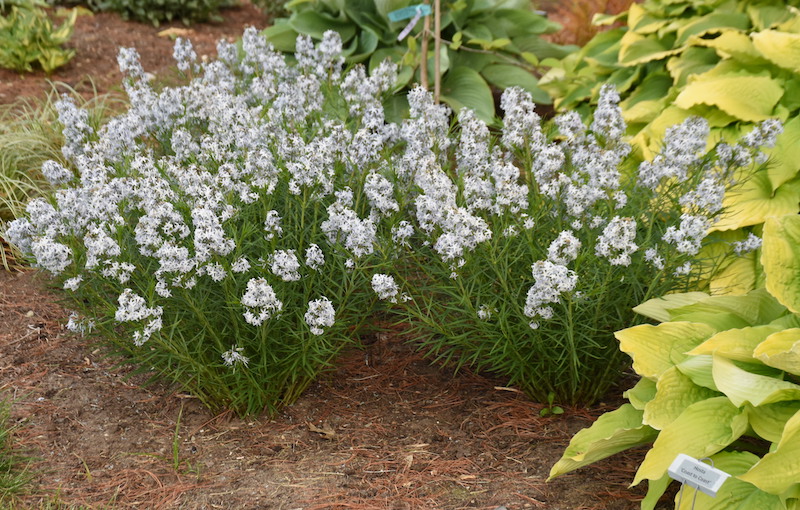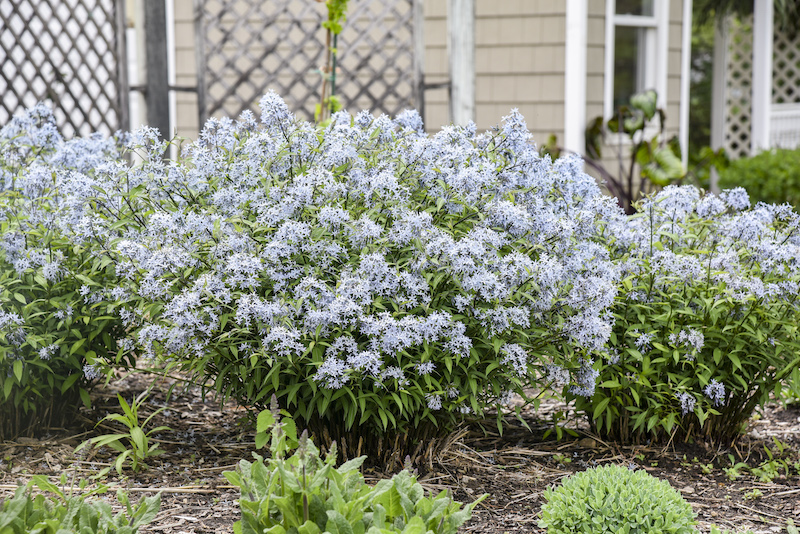Amsonia is the Latin name of the more commonly known Blue Star or Arkansas Blue Star. This is an herbaceous perennial native to the South and Southeast of the United States that tolerates a wide range of soil types and pH levels. Amsonia can adapt to a range of moisture levels in the soil and can be quite drought tolerant at maturity. Native plants such as Amsonia are great additions to pollinator gardens and are generally easy to care for when planted in the correct location.

What You Need To Plant Amsonia
- Transplanting spade
- Hand pruners
- Organic material for mulching such as shredded leaves or arborist chips
- Well-draining soil that retains moisture
- Watering can or hose connection
Where to Plant Amsonia
Amsonia prefers a full sun location but will grow in part sun. If the plant receives less than 6 hours of full sun a day, the stems may become floppy and require staking. The soil texture can be anything from sandy to clay based, although very heavy clay soils should be amended with organic compost to improve drainage and soil aeration. Amsonia is drought resistant at maturity due to its deep, taproot system, which also makes this plant more difficult to transplant.
Amsonia Spacing
Most Amsonia varieties are about 3 feet in width and height. The spreading habit is controlled and not rampant, so there is little risk of Amsonia taking over your garden. Space each plant 3 feet apart when planting en masse. This close spacing will help plants support each other as they grow through the summer. In a mixed perennial border, allow a slightly large spacing between plants, about 4 feet. This will allow good air circulation between plants and highlight the upright shape of the plant.

Steps To Plant Amsonia
Step 1 - Ensure that drainage is good for the location. Amend the soil with 2-3 inches of organic compost if the soil is dense clay. The compost will increase aeration in the soil, allowing the roots to spread and establish better.
Step 2 - Dig a hole that is twice as wide and the same depth as the container the Amsonia plant was grown in.
Step 3 - Gently remove the plant from its pot. Loosen up any roots that have begun to circle the rootball, being careful to not break off the taproot.
Step 4 - Place the rootball in the hole so that the base of the plant is even with the soil level.
Step 5 - Gently replace the soil in the hole, getting rid of any air pockets and holding the plant straight.
Step 6 - Water in the plant well. This may make the soil level sink a bit as all of the large air pockets fill in. Add more garden soil if the roots are still showing.
Step 7 - Mulch the root zone of the plant with 2-3 inches of organic material, avoiding contact with the base of the stems, to aid in moisture retention and suppress weeds.
Step 8 - Prune back any stems that have been damaged or broken during planting.
When to Plant Amsonia
Amsonia can be planted in the spring as soon as the soil is dry enough to dig. The ideal time to plant is on an overcast and cool day, maybe with a light drizzle. This will greatly reduce any transplanting shock and help the plant to establish quickly. Container-grown plants are easily transplanted during other times of the year but will require extra watering if planted during hot or dry periods.
Transplanting Amsonia
Amsonia are best divided in the spring or the fall while they are dormant. Cut back any top growth and dig out the clump, extracting as much of the rootball possible. Look for the sprouts (or eyes) on the roots and include at least two in each divided chunk of the rootball. Replant each division as soon as possible and water it consistently for the first season. Amsonia is also easy to grow from seed. The seed should be planted in the fall and requires a period of chilling through the winter (stratification) before germinating in the spring.
 |
Author Robbin Small - Published 6-06-2023 |
